Your Favorite
All are invited to leave a comment letting us know which of today’s four featured images they like best. As always, please let us know why you made your choice. Comparative comments are also welcome. I will share my favorites in order from one to four here in a few days. Along with my reasons.
What’s Up?
I had a great Sunday morning with R5/RF 100-500 shooter Steve King. We both learned a ton. We photographed Laughing and Ring-billed Gulls, Brown Pelicans in flight, and several species of shorebirds (including two tame Whimbrels!), and several species of egrets and herons. While it was mostly sunny, we did have a few clouds come over at times. This gave Steve the opportunity learn the differences involved when determining the correct exposures in bright sun as compared to cloudy conditions. Steve also learned about staying on sun angle, keeping his left palm to the sky when hand holding, and about the strategies used when photographing birds flapping after their baths. And I have an idea involving the Lock Button on the R5 to eliminate an annoying problem with the R5; I will be exploring a possible solution soon. I created 1866 still-to-be edited images.
Steve kindly loaned me his RF 2X teleconverter. I was pretty much astounded by the R5/RF 100-500/2RF 2X TC combination. Face Detection plus Tracking AF was fast, responsive, and accurate. And a quick peek at the images revealed that they are astoundingly sharp. I will be sharing some of them with you here soon. While a 600-1000mm zoom lens is nothing to sneeze at, you need to pick your spots carefully; the wide open aperture at 500mm is f/14. In the bright sun, I worked at ISO 800 and 1000, used shutter speeds ranging from 1/500 to 1/1000 second, and apertures ranging from f/14 to f/20. Do understand that precise framing while hand holding at 1000mm is a huge challenge, especially if the birds are moving at all. In low light this combination will require the use of exceedingly high ISOs … All that said, I will almost surely be purchasing a Canon Extender RF 2x from Steve Elkins at Bedfords this week.
I was glad to learn that Anthony Ardito sold his SONY a7r iv body for a BAA record-low $1998.00. The winner of the $25.00 BAA store-credit ID quiz will be revealed tomorrow.
Today is Monday 1 March 2021; can you believe that it is already March??? The forecast for this morning is “partly cloudy” with south winds. I peeked out the back door at 7:00am to see clear skies everywhere. Though I have a ton of work to do, I will head down to the lake soon for a short session.
It is now 8:00am and I am sitting in my SUV working on finishing this blog post. I am parked, square to the sun, 60 feet from the long-dead road-killed raccoon, liberated from the fridge for just this occasion. There is a light breeze from the south so all I need is a few interested vultures, or a hungry Bald Eagle …
8:22am: I missed an incoming Black Vulture. I snapped a few frames of it standing near the raccoon but after a few minutes, it flew off. Back to the blog post.
8:36am: I saw an adult Bald Eagle flying right at the raccoon. I lowered the exposure (ISO) three clicks from the vulture exposure as I rated the rig to my eye, but as I had been photographing the raccoon alone I had an off-centered single-AF point. By the time I got where I needed to be, the eagle had flown well past sun angle. Had I been a bit more familiar with my Canon gear I would have gotten a few pretty good frames …
8:50am: a young Bald Eagle flew by at a distance, once having a brief interaction with an Osprey.
8:56am: a dozen Turkey Vultures circled overhead …
9:02am: two landed. One took off.
9:09am: I am about to hit Publish and give up for today. Perhaps I should have brought down some smoked salmon skins and a defrosted fish head or two … Now that would have been cheating!
Wherever you are and whatever you are doing, I hope that you have a great day.
I should have mentioned yesterday that my fine dinner at Left Bank Bistro was the first time I had eaten in a restaurant in more than a year. And that the money I spent was more than I had ever spent on a dining-alone meal.
This blog post took two hours to prepare and makes seventy days in a row with a new one. Please remember …
Please Remember
With income from IPTs now at zero, please, if you enjoy and learn from the blog, remember to use one of my two affiliate programs when purchasing new gear. Doing so just might make it possible for me to avoid having to try to get a job as a Walmart greeter and will not cost you a single penny more. And if you use Bedfords and remember to enter the BIRDSASART code at checkout, you will save 3% on every order and enjoy free second-day air shipping. In these crazy times — I am out at least forty to sixty thousand dollars so far due to COVID 19 (with lots more to come) — remembering to use my B&H link or to shop at Bedfords will help me out a ton and be greatly appreciated. Overseas folks who cannot order from the US because of import fees, duties, and taxes, are invited to help out by clicking here to leave a blog thank you gift if they see fit.
|
|
|
134 sold to rave reviews. The SONY e-Guide by Patrick Sparkman and Arthur Morris |
The Sony Camera User’s e-Guide (and Videos)
Click here to purchase the guide with one Camera Set-up Video. Be sure to e-mail us by clicking here to specify your camera body so that we can send you a link for the correct video.
Click here to purchase the guide with two Camera Set-up Videos. Be sure to e-mail us by clicking here to specify your two camera bodies so that we can send you links for the correct videos.
Click here to learn more about the SONY e-Guide.
Folks who have used my B&H affiliate links or purchased their SONY gear are invited to e-mail for discount information.
|
|
RawDigger e-Guide with Two Videos |
The RawDigger e-Guide with Two Videos
by Arthur Morris with Patrick Sparkman
The RawDigger e-Guide was created only for serious photographers who wish to get the absolute most out of their raw files.
Patrick and I began work on the guide in July 2020. At first we struggled. We asked questions. We learned about Max-G values. We puzzled as to why the Max G values for different cameras were different. IPT veteran Bart Deamer asked lots of questions that we could not answer. We got help from RawDigger creator Iliah Borg. We learned. In December, Patrick came up with an Adapted Histogram that allows us to evaluate the exposures and raw file brightness for all images created with all digital camera bodies from the last two decades. What we learned each time prompted three complete beginning to end re-writes.
The point of the guide is to teach you to truly expose to the mega-Expose-to-the-Right so that you will minimize noise, maximize image quality, best utilize your camera’s dynamic range, and attain the highest possible level of shadow detail in your RAW files in every situation. In addition, your properly exposed RAW files will contain more tonal information and feature the smoothest possible transitions between tones. And your optimized images will feature rich, accurate color.
We teach you why the GREEN channel is almost always the first to over-expose. We save you money by advising you which version of RawDigger you need. We teach you how to interpret the Max G values for your Canon, Nikon, and SONY camera bodies. It is very likely that the Shock-your-World section will shock you. And lastly — thanks to the technical and practical brilliance of Patrick Sparkman — we teach you a simple way to quickly and easily evaluate your exposures and raw file brightness using an Adapted RawDigger histogram.
The flower video takes you through a session where artie edits a folder of images in Capture One while checking the exposures and Max-G values in RawDigger. The Adapted Histogram video examines a series of recent images with the pink histograms and covers lots of fine points including and especially how to deal with specular highlights. The directions for setting up the Adapted Histogram are in the text.
If we priced this guide based on how much effort we put into it, it would sell it for $999.00. But as this guide will be purchased only by a limited number of serious photographers, we have priced it at $51.00. You can order yours here in the BAA Online Store.
Canon EOS R5 Camera User’s e-Guide
On Thursday, I sent out about a dozen copies of the almost finished Canon EOS R5 Camera User’s e-Guide for review to folks who had previously gotten free copies of the R5/R6 AF e-Guide by using my affiliate links to purchase their Canon mirrorless gear. In the same vein, I will be contacting everyone who purchased the R5/R6 AF e-Guide on Monday.
Because the camera and the Menus are so complex, this guide has required a ton of research, a lot of time, and a lot of effort (and will continue to do so until it is complete). It should be finished by the first week in March. 2021. The final update of the R5/R6 AF e-Guide has become part of the complete Camera User’s e-Guide; it will be revised if warranted.
The complete Camera User’s guide will sell for $75.00. Folks who purchased their Canon gear using my links will receive a $65.00 discount; the guide will cost them a nominal $10.00. Folks who spent more than $7500.00 on Canon mirrorless gear using either of my affiliate links (B&H or Bedfords), will receive the User’s Guide for free. Folks who purchased the R5/R6 AF e-Guide will receive a $10.00 discount on the User’s e-Guide. The best news is that the end is in sight.
New and Better Bedfords Discount Policy!
You can now save 3% on all of your Bedfords photo gear purchases by entering the BIRDSASART coupon code at checkout. Your discount will be applied to your pre-tax total. In addition, by using the code you will get 2nd day air shipping via Fed Ex.
Grab a Nikon AF-S Teleconverter TC-14E III and save $14.99. Purchase a Canon EOS R5 and your discount will be $116.97. Purchase a Sony FE 600mm f/4 GM OSS lens and save a remarkable $389.94! Your Bedford’s purchase no longer needs to be greater than $1,000.00 for you to receive a discount. The more you spend, the more you save.
Money Saving Reminder
Many have learned that if you need a hot photo item that is out of stock at B&H and would enjoy free second-day air shipping, your best bet is to click here, place an order with Bedfords, and enter the coupon code BIRDSASART at checkout. If an item is out of stock, contact Steve Elkins via e-mail or on his cell phone at (479) 381-2592 (Central time). Be sure to mention the BIRDSASART coupon code and use it for your online order to save 3% and enjoy free 2nd-day air shipping. Steve has been great at getting folks the hot items that are out of stock at B&H and everywhere else. The wait lists at the big stores can be a year or longer for the hard to get items. Steve will surely get you your gear long before that. For the past year, he has been helping BAA Blog folks get their hands on items like the SONY a9 ii, the SONY 200-600 G OSS lens, the Canon EOS R5, the Canon RF 100-500mm lens, and the Nikon 500mm PF. Steve is personable, helpful, and eager to please.


Gear Questions and Advice
Too many folks attending BAA IPTs (remember those?) and dozens of photographers whom I see in the field and on BPN, are–out of ignorance–using the wrong gear especially when it comes to tripods and more especially, tripod heads… Please know that I am always glad to answer your gear questions via e-mail. Those questions might deal with systems, camera bodies, accessories, and/or lens choices and decisions.
|
|
|
This image was created on 27 February 2021 at my back-up morning location at Fort DeSoto Park. I used the Induro GIT 304L/Levered-clamp FlexShooter Pro-mounted Sony FE 600mm f/4 GM OSS lens, the Sony FE 2.0x Teleconverter, and the blazingly fast AF King, the Sony Alpha a9 II Mirrorless Digital camera body). ISO 500. The exposure was determined by Zebras with ISO on the rear wheel: 1/1250 sec. at f/9 (stopped down 1/3-stop) in Manual mode. RawDigger showed this exposure to be less than 1/3 stop under, i.e., almost perfect. AWB at 8:01:43am on a clear morning. Upper Left Zone/AF-C was active at the moment of exposure and performed to absolute perfection by painting the bird’s eye with AF points. Image #1: Laughing Gull — adult breeding plumage display calling/vertical front-end image design |
I Knew Exactly What I Wanted …
I knew exactly what I wanted: clean tight and graphic head shots of a killer-plumaged Laughing Gull with a bit of behavior thrown in for good measure. So I set the tripod up low for seated shooting and added the 2X TC to the 600 GM/a9 ii. This bird flew in almost on sun angle and began calling. I moved the Zone to the upper left position, acquired focus, and fired off an eight-frame sequence. All were sharp and pretty and pretty dramatic. The one with the perfectly placed wavelet in the lower left corner of the frame was the easy pick.
|
|
|
This image was also created on 27 February 2021 at my back-up morning location at Fort DeSoto Park. I used the Induro GIT 304L/Levered-clamp FlexShooter Pro-mounted Sony FE 600mm f/4 GM OSS lens, the Sony FE 2.0x Teleconverter, and the blazingly fast AF King, the Sony Alpha a9 II Mirrorless Digital camera body). ISO 800. The exposure was determined by Zebras with ISO on the rear wheel: 1/2000 sec. at f/9 (stopped down 1/3-stop) in Manual mode. RawDigger showed this exposure to be perfect. AWB at 8:05:14am on a clear morning. Upper Right Zone/AF-C was active at the moment of exposure and performed to absolute perfection, again by painting the bird’s eye with AF points. Click on the image to enjoy a larger version. Image #2: Laughing Gull — adult breeding plumage preening neck |
Getting Better
I should have mentioned above that this individual was the most perfect Laughing Gull in all of Florida: full breeding plumage with a totally clean face and bill. As it was by itself for the most part, I did not have to worry much about isolating the subject. The bird moved toward me to just right of sun angle so I scootched a bit forward and a bit to my right. When it began preening its neck I quickly and easily moved the Zone to the upper right position and created a short sequence. Even at 20 frames per second these behavioral situations do not last very long. With this one I love the bill tip buried in the white feathers, the almost pure blue background, and the absolutely perfect head angle.
|
|
|
This image was also created on 27 February 2021 at my back-up morning location at Fort DeSoto Park. I used the Induro GIT 304L/Levered-clamp FlexShooter Pro-mounted Sony FE 600mm f/4 GM OSS lens, the Sony FE 2.0x Teleconverter, and the blazingly fast AF King, the Sony Alpha a9 II Mirrorless Digital camera body). ISO 800. The exposure was determined by Zebras with ISO on the rear wheel: 1/2000 sec. at f/9 (stopped down 1/3-stop) in Manual mode. RawDigger showed this exposure to be perfect. AWB at 8:07:01am on a clear morning. Center Zone/AF-C was active at the moment of exposure and performed well. The active AF points were on the base of the bird’s neck, on the exact same plane as the bird’s eye. Click on the image to enjoy a larger version. Image #3: Laughing Gull — adult breeding plumage calling/horiztonal |
More Calling
The bird stayed put right in front of me and right on sun angle. I would guess that I was about 25 feet from the subject. Or maybe a few feet closer. It is likely that had I moved the Zone to upper center, that the system would have grabbed the eye. But no matter, the base of the bird’s neck was on the same plane as the bird’s eye. The variegated background with shades of blue and grey was the result of breaking waves rendered totally out of focus.
|
|
|
This image was also created on 27 February 2021 at my back-up morning location at Fort DeSoto Park. I used the Induro GIT 304L/Levered-clamp FlexShooter Pro-mounted Sony FE 600mm f/4 GM OSS lens, the Sony FE 2.0x Teleconverter, and the blazingly fast AF King, the Sony Alpha a9 II Mirrorless Digital camera body). ISO 800. The exposure was determined by Zebras with ISO on the rear wheel: 1/2000 sec. at f/9 (stopped down 1/3-stop) in Manual mode. RawDigger showed this exposure to be perfect. AWB at 8:07:21am on a clear morning. Center Zone/AF-C was active at the moment of exposure and performed well. The active AF points were on the spot where the hood meets the upper breast just below the very base of the bird’s bill. Again, on the exact same plane as the bird’s eye. Click on the image to enjoy a larger version. Image #4: Laughing Gull — adult breeding plumage/head and shoulders portrait |
The Ultimate Head and Shoulders Portrait
This is the one I came for: clean, tight and graphic — a gorgeous bird, nicely framed, right on sun angle, and with the perfect head — two degrees toward.
I did see one courtship feeding and lots of displaying. On the two DeSoto IPTs, there will be dozens of equally beautiful, easy-to-photograph Laughing Gulls. We will surely have some chances to photograph them (as well as Royal and possibly Sandwich Terns), performing various courtship displays including the copulatory stands that often end with the pair copulating. Do consider joining me.
|
|
|
All of the images were created at Fort DeSoto in April or early May. Click on the card to enjoy a larger version. Fort DeSoto IPT card A |
Fort DeSoto Spring IPT #1
Fort DeSoto Spring IPT #1. 3 1/2 DAYS. SAT 10 APR thru the morning session on TEUS 13 APR 2021. $1499 includes three lunches. Limit: 6. Openings 5.
While DeSoto is one of the rare photo hotspots with the potential to be great any day of the year, it absolutely shines in spring. Many of the wading birds and shorebirds are in full breeding plumage. The terns and gulls are courting and copulating. We will have lots of flight photography opportunities. Did I mention that many of the birds are silly tame?
A $499 deposit is required to hold your spot for this IPT. You can send a check (made out to “BIRDS AS ART) to us here: BIRDS AS ART, PO Box 7245, Indian Lake Estates, FL, 33855, or call Jim or Jennifer at the office with a credit card at 863-692-0906. Your balance, payable only by check, is due immediately after you sign up. If you have any questions, please feel free to contact me via e-mail. If you cancel due to COVID 19 concerns, all of your payments will be refunded.
|
|
|
All of the images were created at Fort DeSoto in April or early May. Click on the card to enjoy a larger version. Fort DeSoto IPT card B |
Fort DeSoto Spring IPT #2
Fort DeSoto Spring IPT #2. 3 1/2 DAYS. MON 26 APR thru the morning session on THURS 29 APR 2021. $1499 includes three lunches. Limit: 6.
Not only am I conversant in all three major camera systems used in the US — Nikon, Canon, and SONY (sorry Andy Rouse …), I have used all three within the past four years. Those include both SONY and Canon mirrorless. On both of these IPTs you will learn how to get the best exposure, how to get the most out of your AF system, and how to get close to free and wild birds. And tons more.
A $499 deposit is required to hold your spot for this IPT. You can send a check (made out to “BIRDS AS ART) to us here: BIRDS AS ART, PO Box 7245, Indian Lake Estates, FL, 33855, or call Jim or Jennifer at the office with a credit card at 863-692-0906. Your balance, payable only by check, is due immediately after you sign up. If you have any questions, please feel free to contact me via e-mail. If you cancel due to COVID 19 concerns, all of your payments will be refunded.
|
|
|
All of the images were created at Fort DeSoto in April or early May. Click on the card to enjoy a larger version. Fort DeSoto IPT card C |
Fort DeSoto Spring IPTs Expected Species
With any luck, we should get to photograph the following species: Laughing, Ring-billed, Herring, and Lesser Black-backed Gull; Royal, Sandwich, and Forster’s Tern: Great, Snowy, and white and dark morph Reddish Egret and Great Blue, Little Blue, and Tricolored Heron; Yellow-crowned Night-Heron, Wood Stork, Roseate Spoonbill, and Brown Pelican. We will see and photograph lots of shorebirds including American Oystercatcher, Black-bellied, Wilson’s, Semipalmated, Snowy, and Piping Plover, Marbled Godwit, Willet, Dunlin, Red Knot, Sanderling, and Western and possibly White-rumped Sandpiper.
Sign up for both IPTs and enjoy a $200 discount. Most of us will be staying in nearby Gulfport.
Typos
In all blog posts and Bulletins, feel free to e-mail or to leave a comment regarding any typos or errors.

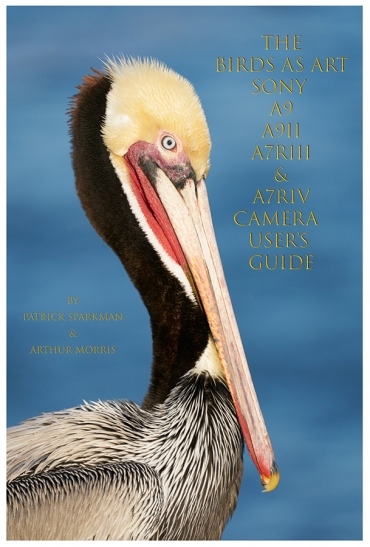


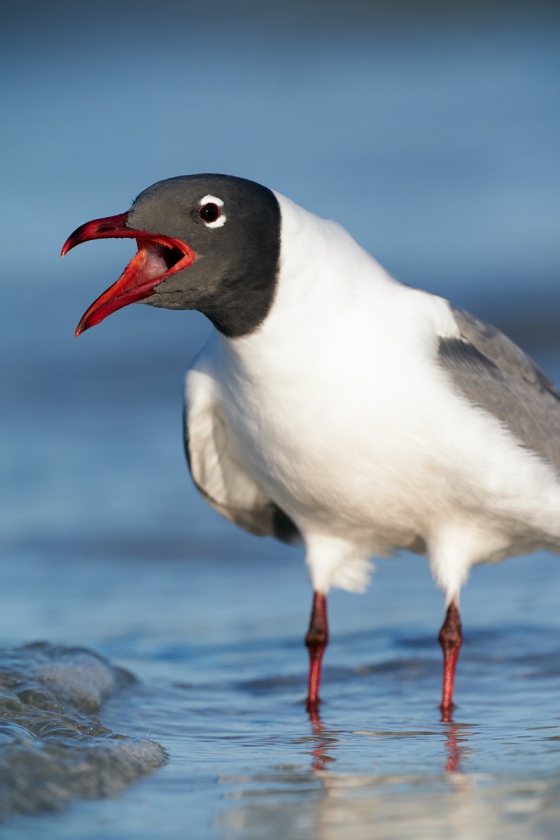
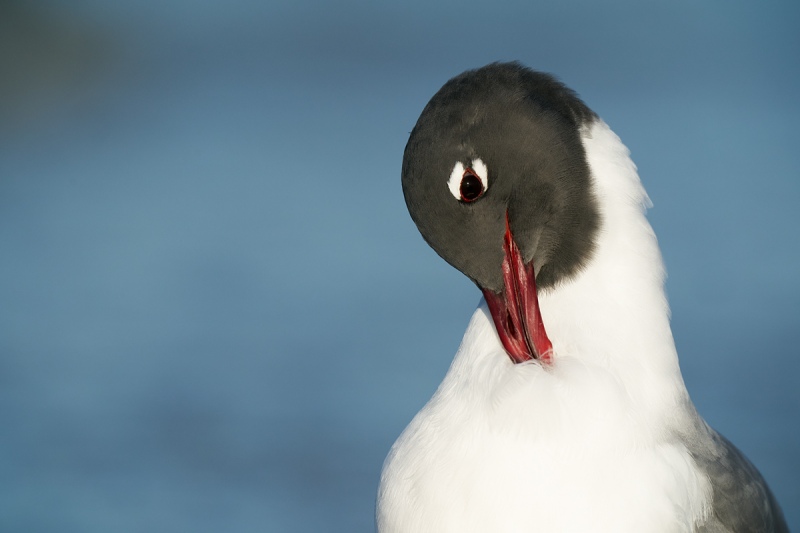
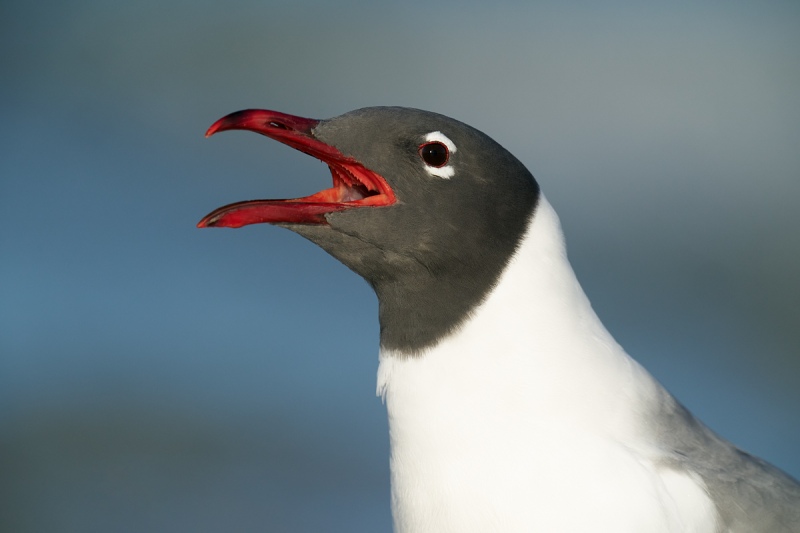
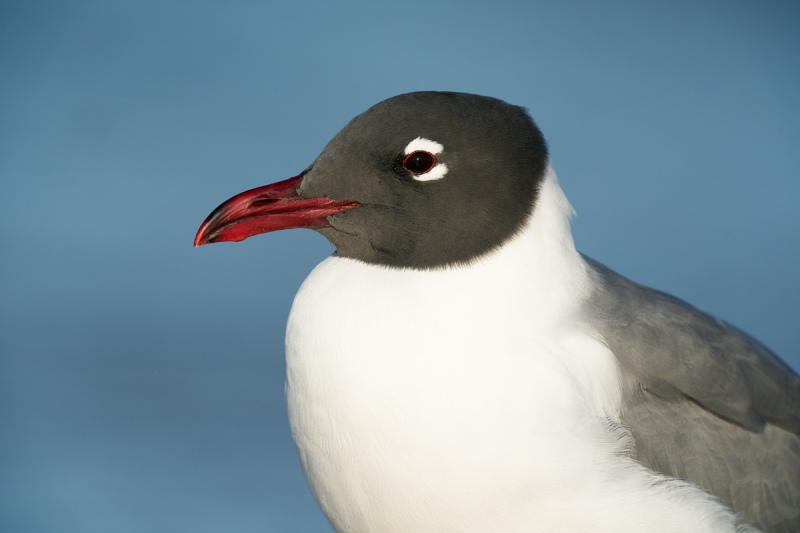
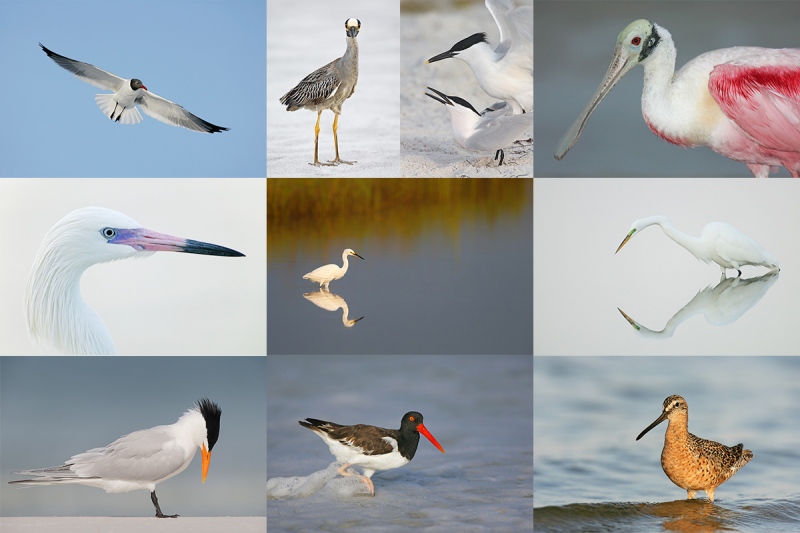
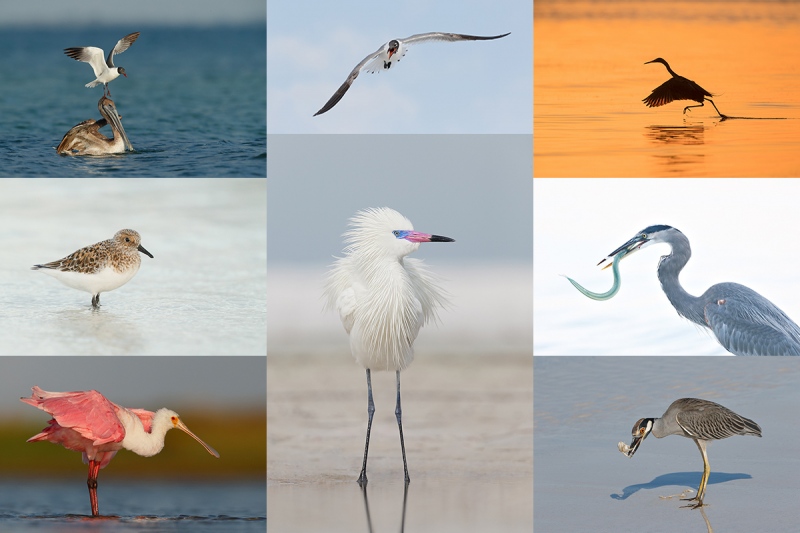
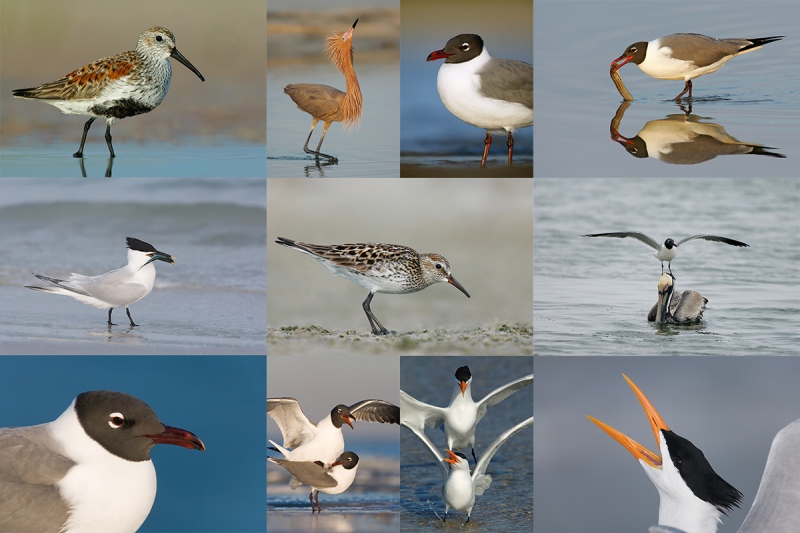













3 for me. I like the composition, red color around the mouth and background in the image. For me the lesser amount of white on the bird’s chest helps the image.
For me, definitely #2. It has the “ah” factor. I like the offset position of the bird, enhancing the soft wonderfully lovely blue background. Even-though I know gulls, and all species of birds, can exhibit aggressive behavior, as demonstrated in 1 and 3, there is also the “soft/personal” side. #2 shows that behavior, which I like by comparison to the others, at least at the moment. Tomorrow I might feel differently. Additionally, technically spot on.
Can’t imaging working with two different camera systems. I will be curious whether you feel that way once you get “the one”. Any feedback on availability?
Thanks, Frank. Working with two systems is a real pain. I have the cameras set up as similarly as possible. I like the position or the Index Finger dial on the R5 better than on the SONY bodies. But I struggle to find the INFO button on the R5.
with love, artie
ps: Feel what way? The RF 100-500 will always be lighter, smaller, and easier to hand hold than the SONY 200-600 and it will always focus closer. And it will always be 1/3 stop slower 🙂
pps: I am supposed to be getting five SONY Alpha a1 bodies delivered on about March 12 or 13 or 14 — two for me and three for two friends.
Artie, I love both #3 and #4, but lean to #3 overall. Beautiful clarity and you’ve captured the Laughing Gull actually in the act of laughing. Cheers.
Wow Artie,
Incredible shots. #4 is my favorite. Masterful portrait, the bird and the background. It gets better every time I click on it! Love the ‘3d’ish look to #1. The dark spot in the upper left of #2 pulls your eye away from the bird. #3 is a wonderful shot.
Best,
Joe
Thanks, Joe!
with love, a
ps: for some folks, the dark area ULC might be seen as balancing the composition …
What a handsome bird ! #1 for me because:
–The camera appears to be level with the bird. Probably not because you were using 1200mm. Anyway I always like subjects and camera level with each other. Makes the viewer equal with the subject.
–of the Vertical composition with the bird creating a diagonal leading to its bill. Red bill and legs balancing each other. Moving from legs to bill create a diagonal as well. I would have gone to horizontal to get the whole bird but I think vertical is far better composition.
–the blue brings out the reds
–there’s a lot of story here–bird’s legs in the water, bird calling, wave at bottom left.
–of the OOF background
I love #1, it almost has a 3D look to it with the slight blurring of the body and the super crisp head. The action in the photo tells a story, causing me to spend more time with the photo.
All are great, but #1 is definitely my favorite. For me, the water detail and the legs add a lot of interest, and the wings being slightly away from the body makes it feel even more like a mid-action capture than the others. Also, having the bird facing slightly more towards the viewer is a bit more engaging, to my eyes.
Hi Artie
I think #2 it is so ascetically pleasing on the eye I think the birds breast is a tad over but I am nit picking. Next #1 and it is sharp where it needs to be and is doing something they our all good usable images.
Best and love
Ken
Hi Ken,
Thanks for leaving a comment.
You are not nit-picking, you are just wrong. But only 100% wrong. The lower center or the breast has the brightest WHITEs but the highest RGB values are in the very low 250s, but most in the high 240s (so nothing is overexposed).
with love, artie
#3 perfect comp and action. #1 would have been if rear end was not cut off.
Anthony, Anthony, Anthony. See Chapter Seven, Designing the Image, in the original soft-cover The Art of Bird Photography, particularly (and coincidentally), the Laughing Gull image on the right side of page 107. The caption there includes the words, then cut off the rear of the bird just behind the legs.
Front-end verticals like Image #1 can be quite powerful as they will reveal much more detail than smaller in the frame images. When working with a fixed focal length lens they are often the best option when you cannot zoom out to include the whole bird in a horizontal frame …
with love, a
#3 is my first choice. I am curious now that you alluded to an annoying behavior on the R5 and can’t wait to learn what that particular item is? Canon Rumors has indicated that the pending firmware update is devoted to further improvements in video with no efforts being made to address the obvious stills deficiencies. If that’s the case, it is disappointing.
Care to elaborate on the “obvious stills deficiencies” comment?
Hi David, I believe that he is referring to the lack of Zebras technology for still shooting (as opposed to video).
with love, artie
Lack of zebras, limited programmability of buttons, and only one ES speed are those which come to mind.
Hi Adam,
Your #2 does not bug me at all. Kudos to Canon for enabling users to save the Customize Buttons and Customize Dials settings with their Customized C1-C3 groups.
You wrote, I am curious now that you alluded to an annoying behavior on the R5 and can’t wait to learn what that particular item is?
I am glad to say that the solution I came up with works. I will be adding this information to the R5 Camera User’s e-Guide.
with love, artie
#2 is by far my favourite. I like the posture of the bird, the composition and the fact that it is performing some feather maintenance.
I prefer #3 — sharp focus plus action! You can’t beat that combination.
Arthur, I liked all four because of great colors and great focusing areas!! And especially 1 and 3 because of “commenting”!! HaHa!!
1, 3, 2, 4. I just love the pose and there is a lot more “interest” in the image for me, particularly, the water and wavelet!
Off topic FYI,
Reading reports that the Sony a1 imbeds large jpgs with raw files making Photo Mechanic users happy.
Full-sized?
Thanks.
a
Yes, that is what is being reported.
Thanks. Time will tell.
with love, a
Howdy Artie
My favorite is #3 the call it is sharp and clear and one can feel the calling, i do like #1 the pose the call the water wave bubbles but it looks soft as if motion blur and maybe that is what you were looking for? When you bumped up the shutter to 2000 and the iso to 800 the images following appear to me to be sharper. I would go with #3.
Please give my love to Brian Sump and his family after learning of his 8 month old having cancer i cannot imaging that what one goes thru with such a young child. I will keep him in my prayers and send love!
with love b
Bob, what looks “soft,” the bird’s head or the wave?
It seems as if you are talking about the bird’s head. If that is the case, you are wrong.
with love, a
Its interesting. When I click on the image, I get a smaller image than the one on the regular web page format. The image on the web page looks sharp on the bill and possibly eye, but the feathers at the edge of the black hood on the neck do look soft. In the smaller image (after clicking on it), the image does look sharper, specifically at the eye and edge of the hood.
But, I do love that pose…
Thanks, Warren. You and Bob are correct.
Bob, click on the image and it gets much sharper. That is good because it is sharp 🙂
with love to both,
a